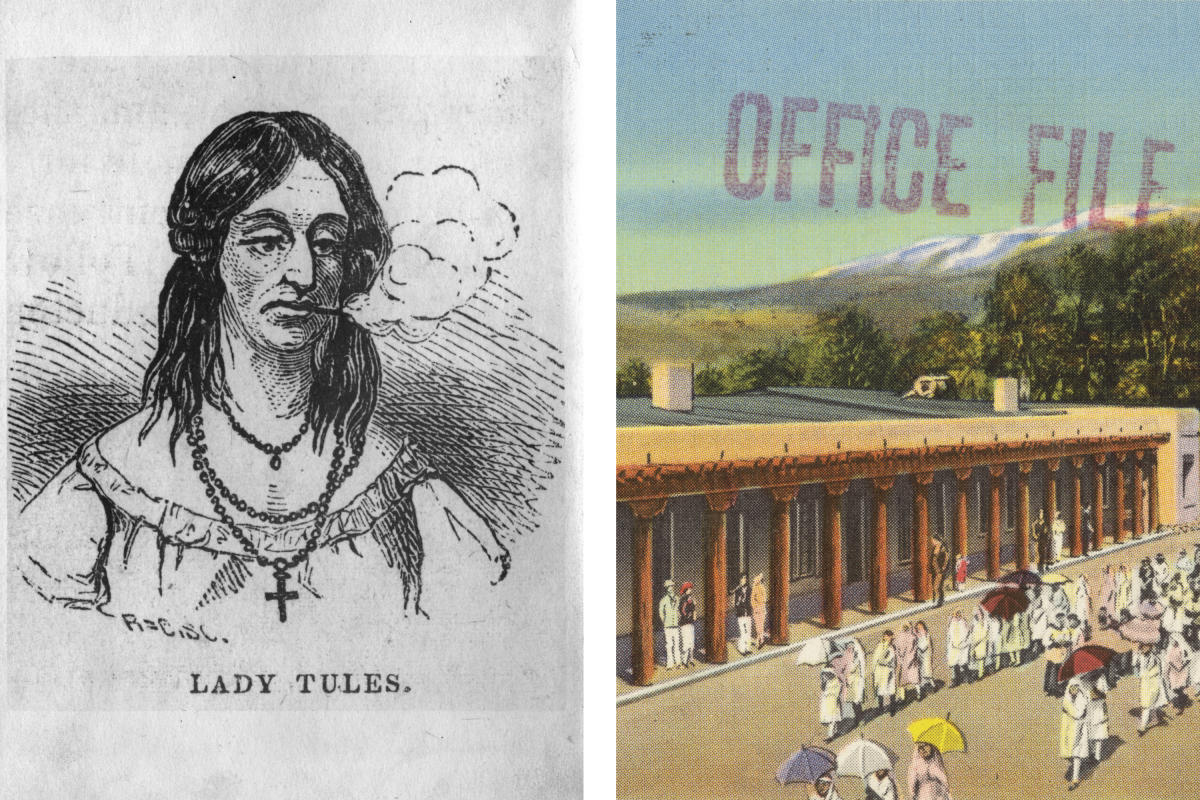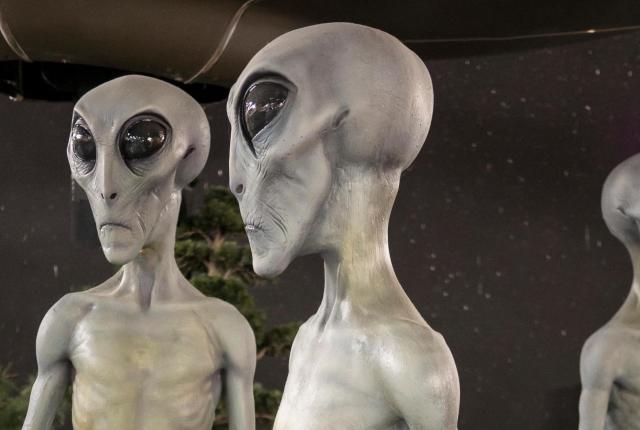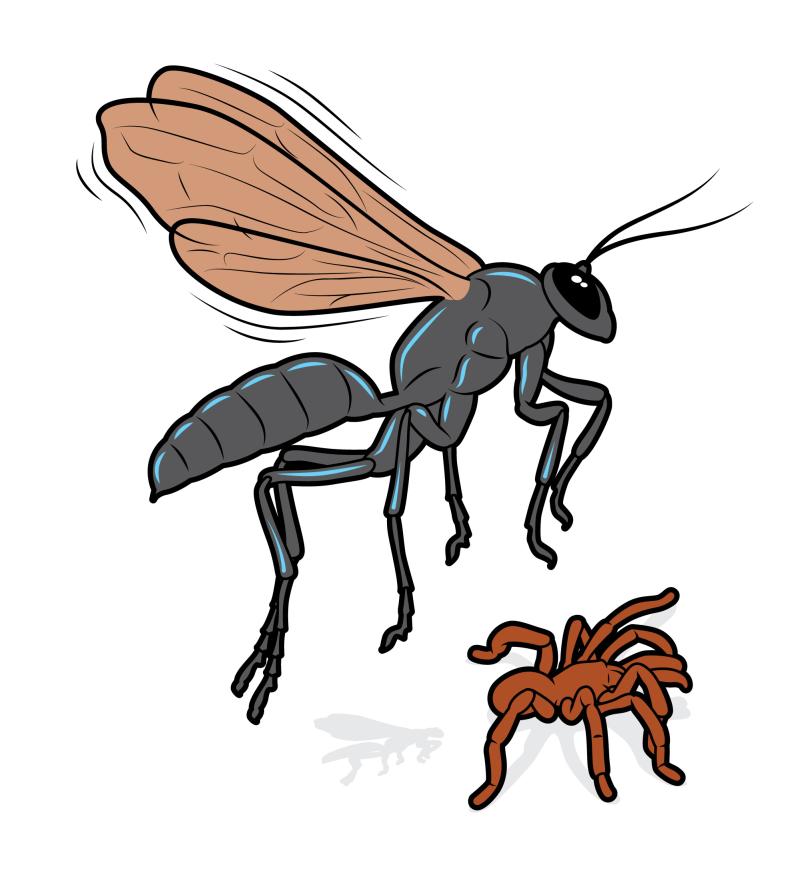Alien models at the International UFO Museum and Research Center, in Roswell. Photograph by Dan Leeth/Alamy.
Weird is Wonderful
Back to Top of ListWeird is Wonderful
AS A KID IN CORRALES, BENJAMIN RADFORD relished reading about ghosts, monsters, and Russian psychics, until one day he wondered, “Why isn’t Walter Cronkite saying ‘Bigfoot is found’ on the evening news?” A skeptic was born, and today Radford serves as deputy editor of Skeptical Inquirer magazine and writes books in which he demystifies the inexplicable; his latest is Big—If True: Adventures in Oddity (Rhombus).
“New Mexico is weird,” he says. “It’s a rural state with a fascinating mix of cultures. Some of the world’s top scientists are working on things too classified for us to know about, and only a few miles away, people are seeing La Llorona in the river.”
That specter, the ghost of a jilted woman who drowned her children in anguish and now haunts waterways seeking fresh children to steal, serves as a sensible warning to little ones and a morality tale to adults, says Ray John de Aragón, an author who explores history and folktales in numerous books, including his most recent, Eerie New Mexico (History Press).
“The wailing woman could appear anywhere at any place you shouldn’t be—alleys, dives, out late at night,” he says. “If you look into history, legend, myths, and folklore, the stories had a basis in truth. There were always morals to teach you a lesson.”
In Diné culture, Skinwalkers are shape-shifting beings that can bring harm to those who stray from a righteous path. Similar figures appear in nearly every culture throughout the world, Radford says.
One of his favorite New Mexico stories is a supposed 1948 UFO crash in Aztec. “This top-secret guy came in and found a box filled with ‘alien technology.’ He was trying to sell it as a bogus oil- and gold-detecting device that he claimed came from Mars. It was all a hoax.”
Radford has been asked to investigate hauntings, often by people who are genuinely frightened. “They’re losing sleep, a marriage is dissolving,” he says. “I’ve been thanked for explaining what’s actually happening.” Even so, he resists the “debunker” label. “That’s not my goal. My goal is to solve a mystery. If the truth is that the dirt at Chimayó can heal, then that’s wonderful to know. To this day, my position is that weird things are interesting.”
Miracles help us keep the faith, and a good scare adds zest. We thrill at tales of buried treasure, gaze at old buildings picturing the troubled spirits within, and keep an eye out for Bigfoot and Chupacabra (the latter most often a coyote with mange, Radford says).
Aragón has uncovered centuries-old spine chillers through stories told by his northern New Mexico family—leavened with a bit of science. The bola de lumbre that leads to either treasure or trouble is just ball lightning, a natural phenomenon, and the oft-told legend of the 16th-century martyred priest whose coffin rose inside of Isleta Pueblo’s mission church was likely due to a Río Grande flood.
“But,” says Aragón, “why did it happen during a drought? And why didn’t the other coffins rise?”
Index of Oddities
Back to Top of List La Doña Tules (left), the owner of a Santa Fe gambling hall and bordello, was buried not far from the Palace of the Governors (right). Photograph courtesy of Digital Commonwealth (left) and Palace of the Governors Photo Archives 050815 (right).
La Doña Tules (left), the owner of a Santa Fe gambling hall and bordello, was buried not far from the Palace of the Governors (right). Photograph courtesy of Digital Commonwealth (left) and Palace of the Governors Photo Archives 050815 (right).
Index of Oddities
We’re Young
New Mexico became a state on January 6, 1912. Arizona steamed into statehood a month later, spoiling our chance to see 47-star flags atop every government building.
We’re Old
Some of our rocks date to 1.8 billion years ago. Paleo-Indians occupied New Mexico around 10,000 years ago. The first time anyone spent a night in the White House, the Palace of the Governors was already 200 years old.
Music, Music, Music
We have an official state song, march, Spanish language song, bilingual song, ballad, and cowboy song. We also have a state guitar to play them.
Dive In
Even at our high elevation, Santa Rosa’s Blue Hole attracts scuba divers. The 81-foot-deep aquatic cavern sits 4,600 feet above sea level.
Botany Lesson
New Mexico has not one but two state vegetables: the chile, which is a fruit; and pinto beans, which are legumes.
Up and Down
The highest point in New Mexico is Wheeler Peak, in Taos, at 13,161 feet. The lowest is the northern end of Red Bluff Reservoir, near Carlsbad, at 2,842 feet.
Friends in Low Places
In 1852, María Gertrudis Barceló, aka La Doña Tules, the owner of a Santa Fe gambling hall and bordello, was buried in La Parroquia Church, predecessor to the Basilica of St. Francis of Assisi. (She left part of her estate to the church.)
Spelling Disaster
Struggles to spell “Albuquerque” could have been worse. Named for New Spain’s Duke of Alburquerque (in today’s Mexico), the name carried an extra “r” that some say a misguided postmaster dropped.
Film First
Thomas Edison produced New Mexico’s first motion picture. The silent Indian Day School (1898) featured Isleta Pueblo schoolchildren. About 40 seconds of it are preserved by the Library of Congress.
No Respect
In 1880, General William T. Sherman said in a speech to New Mexicans, “I hope ten years hence there won’t be an adobe house in the territory. I want to see you learn to make them of brick, with slanting roofs. Yankees don’t like flat roofs, nor roofs of dirt.”
Hit the Road
Back to Top of List The Loretto Chapel’s spiral staircase. Photograph by Richard Maschmeyer/Alamy.
The Loretto Chapel’s spiral staircase. Photograph by Richard Maschmeyer/Alamy.
Hit The Road
Ghost stories: In the village of Cimarrón, the 1872 St. James Hotel markets its reputation for spectral sightings. Management even refuses to rent room 18, saying the spirit of T.J. Wright is just too disruptive. Benjamin Radford has interviewed a longtime Cimarrón resident who insisted the “ghosts” only showed up when the hotel’s ownership changed. Radford doubts you have anything to fear but adds, “Who wouldn’t want to stay in a ghost room?”
Miracle worker: The miraculous staircase at Santa Fe’s Loretto Chapel has welcomed streams of faithful visitors for generations. The legend goes that it was built by the spirit of Saint Joseph, who answered a novena by the chapel’s nuns, used woods and building techniques unknown in 1878, and disappeared before he could be paid. In 2002, historian Mary Jean Straw Cook published her discovery of the real carpenter, François-Jean Rochas, along with a receipt for his work, but the legend persists. Regardless, the staircase is beautiful.
Name games: It’s not just Truth or Consequences. Lots of our towns bear quirky names. Head to Pie Town, where they still serve pie. Spot both a roadrunner and a coyote in Acme. Add some get-up-and-go to Pep. You could imagine the massacre that occurred in Skeleton Canyon, but know that Slaughter Mesa was named after a rancher. Grab a copy of Robert Julyan’s The Place Names of New Mexico (University of New Mexico Press) for Nutt, Weed, Floyd, Queen, Bland, and a lot more.
The Worst
Back to Top of ListPresenting New Mexico's state insect—the Tarantula Hawk. Illustration by Chris Philpot.
The Worst
With a body that looks like it came from a Roger Corman movie and a sting that hurts like a speeding bullet, the tarantula hawk wasp only seems imaginary. Pepsis formosa is very real, and New Mexico’s official state insect. Give it respect—and a wide berth.



